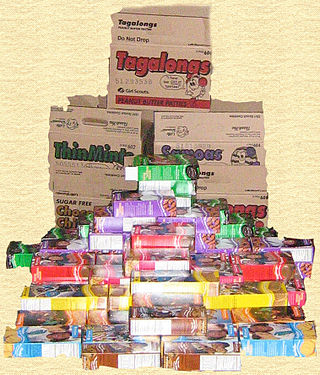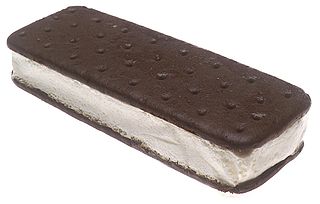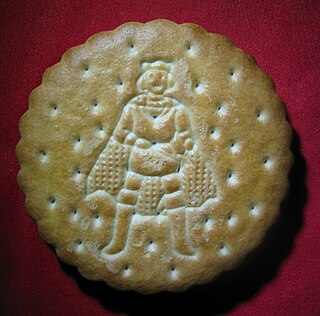
A cookie, or biscuit, is a baked snack or dessert that is typically small, flat, and sweet. It usually contains flour, sugar, egg, and some type of oil, fat, or butter. It may include other ingredients such as raisins, oats, chocolate chips, or nuts.

Oreo is a brand of sandwich cookie consisting of two cocoa biscuits or cookie pieces with a sweet fondant filling. It was introduced by Nabisco on March 6, 1912, and through a series of corporate acquisitions, mergers and splits both Nabisco and the Oreo brand have been owned by Mondelez International since 2012. Oreo cookies are available in over one hundred countries. Many varieties of Oreo cookies have been produced, and limited-edition runs have become popular in the 21st century.

A biscuit, in most English speaking countries, is a flour-based baked and shaped food product. Biscuits are typically hard, flat, and unleavened. They are usually sweet and may be made with sugar, chocolate, icing, jam, ginger, or cinnamon. They can also be savoury, similar to crackers. Types of biscuit include sandwich biscuits, digestive biscuits, ginger biscuits, shortbread biscuits, chocolate chip cookies, chocolate-coated marshmallow treats, Anzac biscuits, biscotti, and speculaas.

Girl Scout Cookies are cookies sold by Girl Scouts in the United States to raise funds to support Girl Scout councils and individual troops. The cookies are widely popular and are commonly sold by going door-to-door, online, through school or town fundraisers, or at "cookie booths" set up at storefronts. The program is intended to both raise money and improve the financial literacy of girls. During an average selling season, more than one million girls sell over 200 million packages of cookies and raise over $800 million. The first known sale of cookies by Girl Scouts was in 1917. Cookie sales are organized by 112 regional Girl Scout councils who select one of two national bakeries to buy cookies from.

A wafer is a crisp, often sweet, very thin, flat, light biscuit, often used to decorate ice cream, and also used as a garnish on some sweet dishes. Wafers can also be made into cookies with cream flavoring sandwiched between them. They frequently have a waffle surface pattern but may also be patterned with insignia of the food's manufacturer or may be patternless. Some chocolate bars, such as Kit Kat and Coffee Crisp, are wafers with chocolate in and around them.

An ice cream sandwich is a frozen dessert consisting of ice cream between two biscuits, wafers, cookies, or baked goods. The ingredients are different around the world, with Ireland using wafers and the United States commonly using cookies.

Reese's Peanut Butter Cups are an American candy by The Hershey Company consisting of a peanut butter cup encased in chocolate. They were created on November 15, 1928, by H. B. Reese, a former dairy farmer and shipping foreman for Milton S. Hershey. Reese left his job with Hershey to start his own candy business. Reese's are a top-selling candy brand worldwide, with more than $2 billion in annual sales generated for The Hershey Company.

Sunshine Biscuits, formerly known as The Loose-Wiles Biscuit Company, is a defunct independent American baker of cookies, crackers, and cereals. The company, which became a brand on a few products such as Cheez-It, was purchased by Keebler Company in 1996, which was purchased by Kellogg Company in 2001. Around then, Sunshine Biscuits was headquartered in Elmhurst, Illinois, where Keebler was located until 2001.

Quality Street is a line of tinned and boxed toffees, chocolates and sweets, first manufactured in 1936 by Mackintosh's in Halifax, West Yorkshire, England. It was named after J. M. Barrie's play Quality Street. Since 1988, the confectionery has been produced by Nestlé. Quality Street has long been a competitor to Cadbury Roses, which were launched by Cadbury in 1938. Nestlé does not distribute Quality Street in the US, but it may be ordered online for delivery, or found in specialty candy shops.

Štark is a food manufacturing company based in Belgrade, Serbia. The main products of the company include candies, biscuits and chocolates. One of its hallmark products is Najlepše Želje a chocolate bar that means "Best Wishes" in Serbian.

Arnott's Group is an Australian producer of biscuits and snack food. Founded in 1865 by William Arnott, they are the largest producer of biscuits in Australia and a subsidiary of KKR.

Crunch is a chocolate bar made of milk chocolate and crisped rice. It is produced globally by Nestlé with the exception of the United States, where it is produced under license by the Ferrara Candy Company, a subsidiary of Ferrero.

A sandwich cookie, also known as a sandwich biscuit, is a type of cookie made from two thin cookies or medium cookies with a filling between them. Many types of fillings are used, such as cream, ganache, buttercream, chocolate, cream cheese, jam, peanut butter, lemon curd, or ice cream.

Prince de LU (Prince) is a biscuit brand made by the enterprise Mondelez International.

Barquillo is a crispy rolled wafer pastry originating in Spain. It is made from the basic cookie ingredients of flour, sugar, egg whites and butter rolled out thinly and then shaped into a hollow cylinder or a cone. It was traditionally sold by roadside vendors known as barquilleros who carried a characteristic red roulette tin. It was introduced to Latin America and the Philippines during colonial times. In Spain and former Spanish colonies, barquillos are commonly regarded as a type of Christmas cookie. It is also popular during various fiestas. It spread to neighboring countries and today is extremely popular in East and Southeast Asian countries.

Negresco is a Brazilian sandwich cookie brand created by Nestlé, originally being sold by its now defunct subsidiary Biscoitos São Luiz in 1987. The product was created as a competitor to the Oreo brand, consisting of two chocolate biscuits with a filling usually in vanilla flavor. After the end of São Luiz in 2002, the cookies began to be sold under the Nestlé label. It came onto the Brazilian market and is still only sold there as Biscoitos Recheados and Biscoitos Wafer.
















